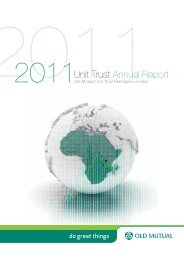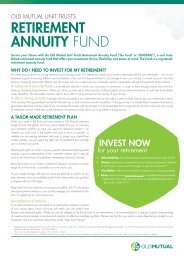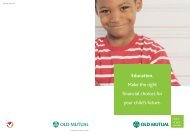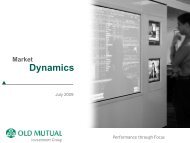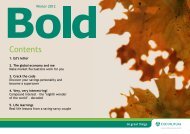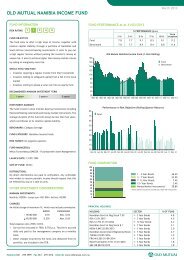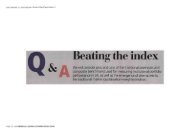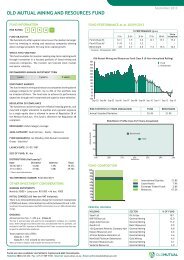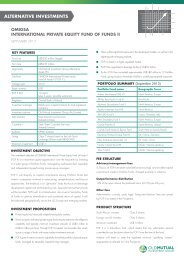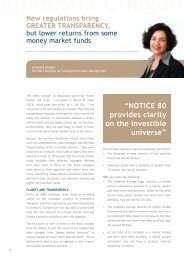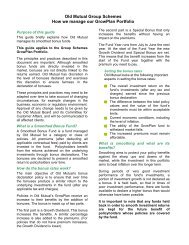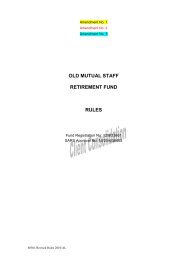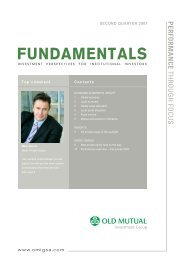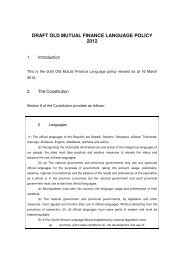Create successful ePaper yourself
Turn your PDF publications into a flip-book with our unique Google optimized e-Paper software.
Asset Allocation:<br />
2011 Outlook<br />
PETER BROOKE<br />
Boutique Head,<br />
Macro Strategy Investments
What did we say last time?<br />
<br />
Themes help strip out the noise<br />
− Big government<br />
− Cash is trash<br />
− Emerging markets<br />
− Low-return world<br />
− Quest for yield<br />
<br />
<br />
<br />
?<br />
<br />
<br />
Expectations are unrealistic<br />
− 65% of investors are going to be disappointed in the long-term<br />
<br />
Expect a better second half of the year<br />
2
Asset Class Returns<br />
For 12 Months to 31.12.10<br />
SA EQUITIES<br />
RAND<br />
RETURNS<br />
(%)<br />
US DOLLAR<br />
RETURNS<br />
(%)<br />
FTSE/SWIX 20.9 35.4<br />
SA Listed Property 29.6 45.2<br />
SA Bonds 15.2 29.0<br />
SA Cash 6.8 19.6<br />
INTERNATIONAL RETURNS<br />
MSCI AC World 1.0 13.2<br />
Emerging Market 6.4 19.2<br />
Bonds -5.0 6.4<br />
Cash -10.3 0.3<br />
3
Biggest driver of asset prices in 2011 was the rand<br />
Rand was the 3 rd strongest major currency in the world<br />
Japanese Yen<br />
Australian Dollar<br />
South African Rand<br />
Swiss Franc<br />
Taiwanese Dollar<br />
Singapore Dollar<br />
New Zealand Dollar<br />
Swedish Krona<br />
Canadian Dollar<br />
Mexican Peso<br />
Brazilian Real<br />
South Korean Won<br />
Norwegian Krone<br />
British Pound<br />
Euro<br />
Danish Krone<br />
-6.7<br />
-6.9<br />
-3.5<br />
-0.7<br />
2.9<br />
7.3<br />
6.4<br />
6.2<br />
5.9<br />
4.9<br />
14.7<br />
14.0<br />
12.0<br />
10.8<br />
9.7<br />
9.5<br />
-10% -5% 0% 5% 10% 15% 20%<br />
4<br />
Source: Bloomberg 31.12.09 to 31.12.10
Interest rate-sensitive assets gained<br />
<br />
<br />
Strong rand suppressed inflation, allowing rates to fall<br />
Lower rates meant capital gains for property and bonds<br />
Total<br />
return<br />
(%)<br />
Starting<br />
yield<br />
31.12.09<br />
(%)<br />
Closing<br />
yield<br />
31.12.10<br />
(%)<br />
Change<br />
in yield<br />
(%)<br />
Property 29.6 8.1 7.3 -0.9 Winner<br />
Bonds 15.2 9.1 8.1 -1.0 Winner<br />
Cash 6.8 7.1 5.5 -1.6 Loser<br />
5
SA relative to Emerging Markets<br />
Jan-93<br />
Jan-94<br />
Jan-95<br />
Jan-96<br />
Jan-97<br />
Jan-98<br />
Jan-99<br />
Jan-00<br />
Jan-01<br />
Jan-02<br />
Jan-03<br />
Jan-04<br />
Jan-05<br />
Jan-06<br />
Jan-07<br />
Jan-08<br />
Jan-09<br />
Jan-10<br />
Strong rand also boosted South Africa’s relative<br />
performance<br />
200<br />
180<br />
160<br />
140<br />
120<br />
10-yr average<br />
100<br />
80<br />
6<br />
Source: MSCI
South Africa best performing major market in US$<br />
12 months to 31.12.10<br />
South Africa<br />
South Korea<br />
Turkey<br />
India<br />
Russia<br />
EM<br />
Pacific<br />
MSCI<br />
S&P 500<br />
FTSE 100<br />
Dax 30<br />
Hang Seng<br />
Brazil<br />
China<br />
Cac 40<br />
Euro Stoxx 50<br />
-6.0<br />
-9.1<br />
9.2<br />
8.5<br />
8.3<br />
6.8<br />
4.8<br />
21.2<br />
20.9<br />
19.4<br />
19.2<br />
16.1<br />
15.6<br />
15.1<br />
27.2<br />
34.2<br />
-15% -10% -5% 0% 5% 10% 15% 20% 25% 30% 35% 40%<br />
SA was beaten by a handful of smaller markets like Thailand, Chile & Indonesia<br />
7<br />
Source: Datastream, Deutsche Bank, OMIGSA
BOTTOM UP<br />
Valuations / HOLT<br />
Research<br />
Screens<br />
What will happen to the rand in 2011?<br />
THEME & PRICE<br />
“Integrating top down<br />
and bottom up”<br />
TOP DOWN<br />
Macro Environment<br />
Markets<br />
Themes<br />
BAD THEME<br />
Deteriorating<br />
Environment<br />
THEME<br />
Improving<br />
Environment<br />
HIGH<br />
Expensive<br />
LOW<br />
Cheap<br />
8
Philosophy: Theme vs. Price<br />
<br />
THEME vs. PRICE<br />
<br />
RAND: REAL EFFECTIVE EXCHANGE RATE<br />
<br />
<br />
Cash is trash<br />
Quest for yield<br />
170<br />
160<br />
140<br />
120<br />
Mean = 114.4<br />
Std. Dev. = 14.7<br />
170<br />
160<br />
140<br />
120<br />
<br />
Emerging markets<br />
100<br />
100<br />
90<br />
90<br />
<br />
Commodities<br />
80<br />
80<br />
70<br />
70<br />
71 74 77 80 83 86 89 92 95 98 01 04 07 10<br />
9<br />
Source: SARB
2011: Headwinds to the themes<br />
<br />
<br />
<br />
<br />
Inflation<br />
− Higher inflation in the emerging world is causing higher interest rates<br />
− South Africa’s interest rate differential is less attractive<br />
US recovery<br />
− An upward “surprise” on growth will focus attention on tighter policy in<br />
2012<br />
Emerging markets<br />
− Remain longer-term bulls, but a well-established theme<br />
− Higher rates create a cyclical headwind<br />
− Create the potential for volatility<br />
Conclusion<br />
− The rand is expensive and is vulnerable to a loss of momentum which is<br />
impossible to time. Reduce exposure and increase offshore<br />
diversification.<br />
10
Why increase offshore exposure?<br />
<br />
Diversification<br />
− Basic argument of don’t put all your eggs in one basket<br />
<br />
Relative value<br />
− Expected real returns<br />
<br />
Currency<br />
− Will REAL currency movement impact returns<br />
11
Diversification<br />
<br />
Theory<br />
− Diversification improves portfolio efficient frontier<br />
− Reduces country-specific risk<br />
<br />
Optimisation<br />
− Our detailed analysis shows optimal portfolios hold more than 35%<br />
internationally<br />
− SA equity volatility 30% higher than international equity volatility<br />
<br />
Opportunity set<br />
− Exposure to faster growth economies in other countries<br />
− Exposure to industries not well represented in South Africa (excluding<br />
resources)<br />
− Exposure to many more companies and instruments<br />
12
Valuation: SA no longer so cheap<br />
South Africa’s Dividend Yield – Japan’s Dividend yield (%)<br />
CHEAP<br />
13<br />
Source: OMIGSA
Expected Return vs Currency Movement<br />
50<br />
40<br />
30<br />
20<br />
SA Cash minus US Cash<br />
SA Bonds minus US Bonds<br />
SA CPI minus US CPI<br />
Rand/US$ Percentage change<br />
STRONG RAND<br />
50<br />
40<br />
30<br />
20<br />
10<br />
10<br />
0<br />
0<br />
-10<br />
-10<br />
-20<br />
-20<br />
-30<br />
-30<br />
-40<br />
-45<br />
WEAK RAND<br />
1963 1968 1973 1978 1983 1988 1993 1998 2003 2008 2013<br />
-40<br />
-45<br />
Over time we expect rand depreciation to boost returns<br />
14
Increase International Exposure<br />
<br />
Diversification, relative value and the strong rand are all<br />
supportive of increased international equity exposure<br />
<br />
Remember that multi-asset class solutions can move to 25% so<br />
for many investors this is already happening<br />
<br />
Japan<br />
− Contrarian trading opportunity<br />
<br />
Africa<br />
− Longer-term opportunity for higher returns<br />
15
Japan<br />
<br />
Nikkei 225 in real terms<br />
<br />
Massive underperfomer, back at levels 30 years ago<br />
Un-loved, under-owned, Price Sales 0.6x<br />
16<br />
Source: Macro Strategy Investments (OMIGSA)
Africa: The Last Frontier<br />
<br />
Population<br />
− More than 1 billion people, youngest workforce in the world,<br />
40% urbanised, 52 cities of more than 1m<br />
<br />
Natural resources<br />
− It’s a big place!<br />
− Resource-rich with mining and agriculture dominating most<br />
economies = leveraged play on Chinese consumer<br />
<br />
Improving opportunity<br />
− Increased FDI, stronger GDP growth, debt and inflation better<br />
controlled<br />
17
OMIGSA’s International Capabilities<br />
<br />
18 distinct asset management firms<br />
globally to choose from within the<br />
OM group with AUM of $262bn<br />
<br />
Exposure to 160 different strategies<br />
covering global equities, fixed<br />
income, property and alternatives<br />
FUND OF HEDGE<br />
FUNDS<br />
LARCH LANE<br />
AFRICAN<br />
EQUITY<br />
LONG TERM EQUITY<br />
INVESTMENTS<br />
<br />
Brought together within simple<br />
solutions by the asset allocation skills<br />
of MSI<br />
18
Expected Returns: Equities<br />
<br />
<br />
<br />
<br />
<br />
<br />
SA equities are fully priced on an absolute basis, but are still<br />
attractive relative to other asset classes<br />
Last year’s return was primarily delivered through earnings growth,<br />
and multiples stayed at high levels of 17.2x<br />
Therefore, earnings growth will be crucial to delivering this year’s<br />
returns<br />
We expect earnings growth of 25%, led by resources<br />
Internationally, we also expect another strong year of corporate<br />
profits as the economy recovers<br />
Excellent corporate balance sheets will also provide plenty of<br />
firepower for corporate action: takeovers, buybacks, dividends<br />
19
Expected Returns: Interest-Bearing Assets<br />
<br />
Inflation will increase from low levels, while local rates will<br />
probably remain flat = lower real returns on cash<br />
<br />
Local bonds will provide an attractive carry relative to cash,<br />
but are unlikely to re-rate<br />
<br />
Local property has been the best performing asset class again,<br />
and as a result we downgrade future real returns<br />
<br />
Offshore bonds remain an asset class to avoid<br />
20
Long-Term Asset Allocation View<br />
Real Return View Comment<br />
SA<br />
Equity<br />
6.0%<br />
Property 5.5%<br />
Bonds 2.5%<br />
Cash 1.5%<br />
International<br />
N<br />
N<br />
N<br />
N<br />
N<br />
Rand is becoming overvalued<br />
Full value on an absolute basis but still<br />
attractive. Grind higher.<br />
Expected return continues to fall<br />
Limited potential for capital gains but<br />
attractive carry vs. cash<br />
Lower rates for longer means lower returns<br />
Diversification is valuable<br />
Equity<br />
6.5%<br />
Preferred asset class for 2011<br />
Bonds 1.0%<br />
Cash 0.0%<br />
Longer-term bearish<br />
Cash is still unattractive<br />
21<br />
NB: These are long-term, real returns expected over the next five years<br />
1 January 2011
Conclusion<br />
<br />
Lower returns from interest-bearing assets<br />
<br />
Lack of alternatives and strong earnings growth should result<br />
in another year of equity outperformance<br />
<br />
Increase offshore diversification<br />
<br />
Overall returns will be lower looking forward – save more<br />
22
<strong>Old</strong> <strong>Mutual</strong> Balanced Fund<br />
Asset Allocation as at 31.12.10<br />
International<br />
17.9%<br />
Cash<br />
16.2%<br />
SA Equities<br />
51.5%<br />
Bonds<br />
7.4%<br />
Commodities<br />
0.6%<br />
Property<br />
6.4%<br />
23



